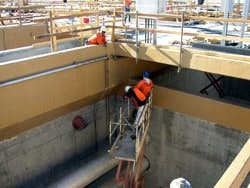Rapidly growing population of this metropolitan Phoenix city was a significant factor in the need to expand. A primary objective of the project was to meet the needs of increased sewage capacity in a manner that the investment in municipal infrastructure would be protected for years to come.
One of the major threats, however, to the longevity of the plant was the potential of aggressive corrosion occurring from microbiological sources. A strain of bacteria commonly found in the wastewater environment ingests hydrogen sulfide and emits sulfuric acid in its respiration process. The acid would directly attack concrete infrastructure if exposed surfaces were left unprotected. This process is known to accelerate in warm climates where the bacteria thrive, so Glendale wisely sought to take preventive action.
Malcolm Pirnie’s Phoenix Office participated in the engineering aspect of the project. Sundt Constructors, Inc. of Tempe, Ariz. joined them in the role of general contractor. Together, they prioritized the selection of an appropriate chemical-resistant lining as a means of preventing future corrosion.
After receiving public bids, the lining application was awarded to Optco of Gilbert, Ariz. Optco’s winning bid included a low permeable polymer lining provided by Sauereisen, Inc. of Pittsburgh, Pa. The lining, SewerGard No. 210T , boasted an extensive track record of withstanding corrosive conditions throughout the Sunbelt states and had been used successfully on an earlier expansion at this same facility.
A key aspect of SewerGard’s functionality is that it not only resists direct exposure to sulfuric acid, but it prevents the acid from penetrating the underlying concrete beneath. This was a key consideration, especially in the vapor zones of structures where microbiologically induced corrosion is often most extensive.
Following surface preparation, Optco applied a "scratch coat" to fill bugholes in the new concrete with the SewerGard epoxy. They then used the same material to apply the full thickness over 85,000 ft2 of area throughout the plant. Versatility of Sauereisen’s lining made it appropriate for several structures including influent junction chambers, the grit removal unit, aeration basins, sedimentation basins, a mixed liquor channel, and an equalization basin.
Applied at a thickness of 125 mils, SewerGard also provided abrasion resistance and the durability to withstand occasional industrial sewerage that makes its way to the plant.
Optco’s crews, directed by company president Allen Kauffman, offered a great deal of experience in applying the lining.
For instance, much of the application took place at night or during periods of declining temperatures. This prevented the entrapment of air underneath the lining that might otherwise compromise the corrosion resistant system in the form of blisters.
As a means of quality control, Malcolm Pirnie specified that the lining be examined for pinholes and adequate thickness in all areas. In addition, a local Sauereisen representative provided job site consultation to confirm that materials were applied in accordance with the manufacturer’s standards.
The end result was a state of the art wastewater reclamation plant. Glendale is now positioned to treat water to high standards for reuse opportunities. Glendale showed further stewardship by constructing a recharge facility to use treated wastewater to replenish the dwindling aquifer.


